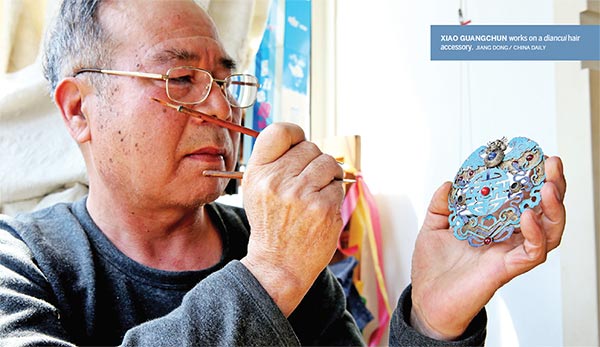 |
|
Xiao Guangchun works on a diancui hair accessory. [Photo by Jiang Dong/China Daily] |
The craftsmanship that makes a plucked feather shine and fly again is called diancui, which literally means "a dip of blue".
In diancui, kingfisher feathers are meticulously cut and glued onto gold or gilt silver to create an iridescent effect like cloisonne, which requires a lot of skill and patience.
"Chinese craftsmen have been using the blue feathers as an inlay for jewelry and fine objects, such as headdresses and fans. The beauty of diancui can also be found in many ancient novels and poems," says Xiao Guangchun, who is one of the very few masters in China still employing very traditional ways to make diancui jewelry for museums, collectors and jewelry designers.
"Diancui's history can be traced back more than 2,000 years, though now many people haven't even heard of it," says Xiao, who, in his 60s, is determined to save the dying craft.
Xiao learned diancui skills from his father more than 30 years ago.
Thanks to tireless efforts in practicing and promoting the art, Xiao was given a certificate in 2013 by Beijing's municipal government as a representative heir of intangible cultural heritage for his skills with diancui.
His son showed no interest in his artistic skills, so Xiao has spent a lot of time persuading his daughter Xiao Yumei to learn the skill, enabling her to become his family's third generation torchbearer of the ancient craft.
Xiao Guangchun is now applying to be a national-level representative heir of diancui.
"I know it is a hard trade, but I can feel the passion of my father and didn't want to let him down," says Xiao Yumei, who, after having apprenticed under his father for many years, can now work independently on diancui objects.
Xiao Yumei quit her job and became a full-time diancui practitioner in 2013. She has been thinking of setting up a workshop in Beijing to promote diancui and at the same time make the quest to preserve the traditional craft into a profitable business.
|
|
|
|
|
|
|
|
